The second edition of LIV Golf Adelaide is coming to town and travel itineraries are filling up fast. Here’s our guide on where to play during your South Australian getaway.
The phone call came last October. Six months out from the second edition of LIV Golf Adelaide, my friend Brett wanted in. He wasn’t the only person to reach out seeking advice for securing tickets plus tee-times at Adelaide courses in late April. Like a lot of Australian golfers, these enquirers needed a television to see the epic spectacle that was LIV’s debut on our shores last year and vowed to be there in person this time. It’s why 80 percent of tickets sold out in the first 24 hours and why demand was even higher this year compared to last – the festival of golf and entertainment in the South Australian capital has golf fans drooling at the prospect of an even bigger staging upon LIV’s return.
Brett secured his tickets and has booked his flights and accommodation as well as snaring a couple of hard-to-get tee-times at tantalising courses in the days after the tournament. He won’t be alone in making a week of it, with plenty of interstate visitors padding their LIV experience with their own golf either before or after the April 26-28 tournament dates.
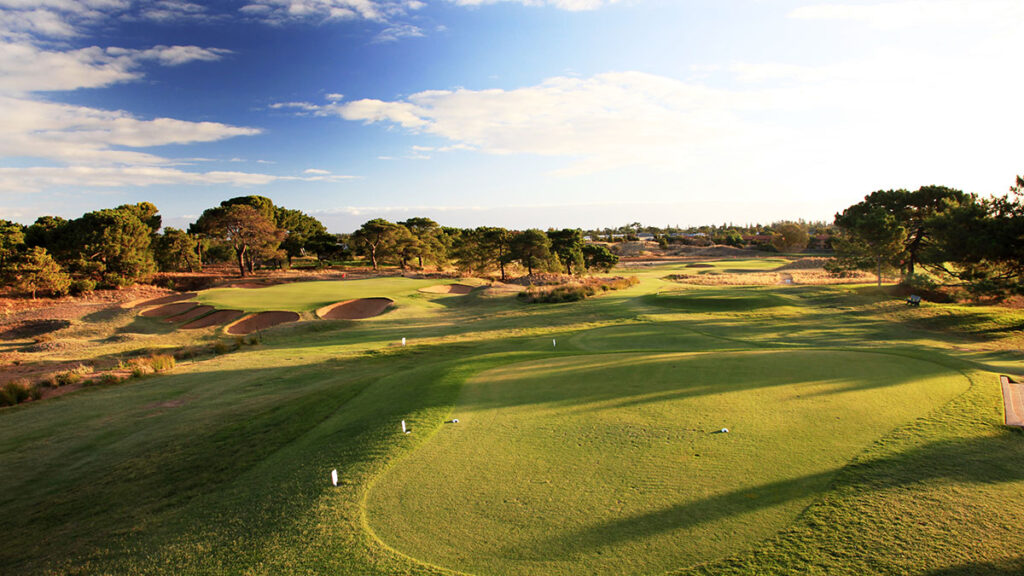
Last year’s inaugural LIV Golf Adelaide was the final leg of a perfect storm on the calendar that began with Easter, rolled into the AFL’s inaugural Gather Round in Adelaide and onto LIV, which was greeted with perfect autumn weather. This year, Easter falls four weeks earlier and the Gather Round sooner by three weeks, leaving LIV Adelaide on its own. Not that it matters; the tournament proved it can draw golfers and sports fans to the city without the help of another sport or a string of public holidays.
The 2023 edition saw an attendance of 77,076 with 37 different countries represented in the galleries at The Grange Golf Club. While naturally inaccessible for play during the week of the tournament – even the 18 holes not in use for the LIV contingent – the club has become a destination in its own right since last April. The number of interstate and international enquiries has risen noticeably since the inaugural LIV Adelaide tournament.
The city’s top-shelf golf options have long revolved around a ‘Big 4’ of Grange, Royal Adelaide, Kooyonga and Glenelg. Which order they sit in depends on personal preference, but there’s no doubting Grange has boosted its appeal through hosting one of the most memorable golf tournaments in Australian golf history. While guest bookings are limited in the month or so either side of the tournament, more and more golfers are enjoying the club’s West and East layouts.
Not much will change from last year to this, an indication that the recipe was right the first time at Grange. The configuration of holes, which is essentially the back nine of both courses, will remain the same. Some of the grandstands and marquees will be a little larger, but otherwise fans who attended last year will recognise the setup when they return next month.
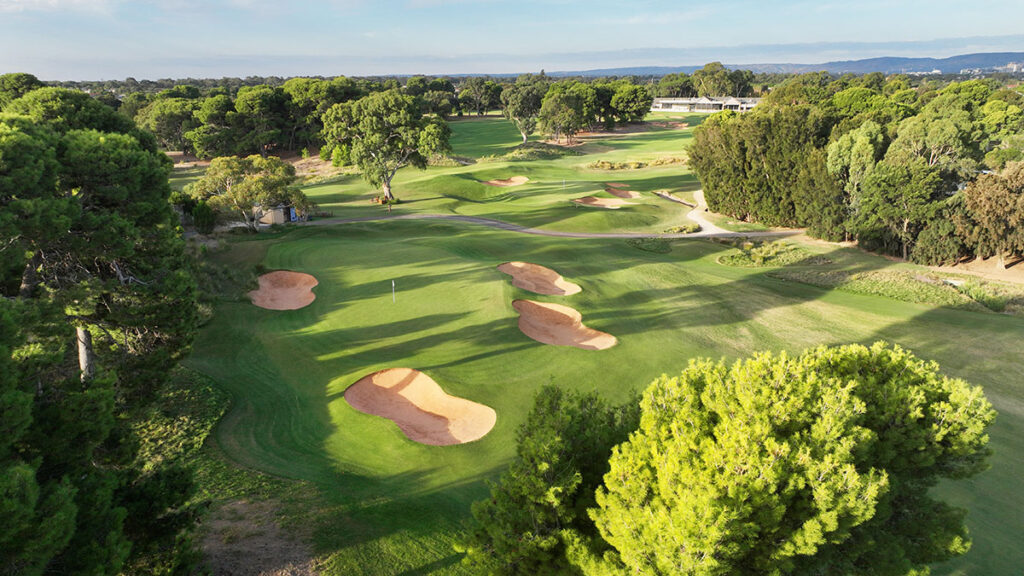
THE TOUGHEST TICKET IN TOWN
If you think securing a ticket to LIV at this late stage is going to prove difficult, try landing a tee-time at the likes of Royal Adelaide, Kooyonga and Glenelg golf clubs that week. And they’re not alone in the demand stakes. Between interstate and international visitors attending LIV and members of reciprocal clubs seeking access, the timesheets of many Adelaide golf clubs that week are fuller than Jon Rahm’s bank account. While naturally a little guarded on the subject, some of the non-Grange clubs we chatted to spoke of six-figure revenue spikes last April and visitors not baulking at paying green fees in the realm of $350 to $400 or more.
There were windfalls to be had by these clubs, for sure, but only if the logistics fell into place and each found a way to manage the increased golfer traffic. At Royal Adelaide, for example, about 400 visitors graced its fairways in the Monday-to-Monday stretch that encompassed LIV last year. That’s a vast increase on a standard week and had to be navigated along with member access. On the busiest days, there were two shotgun starts to maximise player numbers. Demand this year is such that it is shaping as a similar setup this April.
It’s been written plenty of times before, yet the convenience factor of Adelaide’s best golf courses can’t be overstated. You can be on the first tee at Kooyonga in mere minutes after exiting Adelaide Airport, while the other ‘Big 4’ courses aren’t much further away. It makes for a highly manageable experience for travelling between golf courses, accommodation, the city’s restaurants and its other attractions.
Royal Adelaide Golf Club remains the standout option for many visiting golfers, as the perennial top-ranked course in the state. The layout has received several minor tweaks in recent times, some cosmetic but at least one that’s more substantial. Soon to re-open for play is the 10th green, where Tom Doak and Brian Slawnik from Renaissance Golf Design have reworked the putting surface to soften the fall-away at the rear of the green, expand the surface slightly and create more pin positions. Elsewhere is a reshaped bunker next to the 12th green that was altered to improve drainage and playability, although it subtly makes the approach more strategic as the bunker angles into the front-left section of the green more. As the club’s consulting architects, Doak and Slawnik have more enhancements in mind for the coming years.
The on-course activity at Kooyonga Golf Club mostly took place a few years ago with course architect Neil Crafter’s implementation of a Landscape Enhancement Plan and the replacement of several greens plus some bunker reshaping and addition. Most of that work was completed ahead of the club’s anticipated hosting of the 2021 Women’s Australian Open, which wound up being cancelled due to COVID. Nevertheless, the affinity Crafter – the legend of Adelaide and Australian amateur golf who grew up caddieing and playing at Kooyonga – has for the club continues to shine through across the layout, each change taking place in the spirit of the original architect, Cargie Rymill. The most recent alteration? A generous-sized short-game practice area to the left of the first fairway, beyond the expansive main driving range.
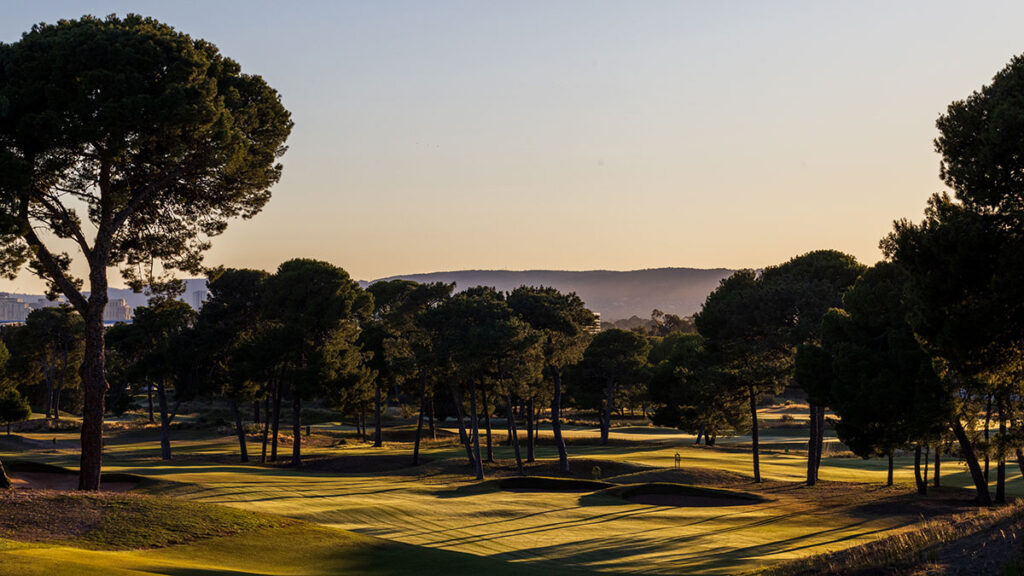
Glenelg Golf Club is currently seeing the most action, Crafter collaborating with Ryan Van Der Veen and club legend Bob Tuohy to, as the club says, “help improve efficiencies, modernise our course and most importantly improve playing surfaces. It will lead to better use of our available resources with the emphasis on the quality of our turf, bunkers and vegetation maintenance to complement and frame the course. These improvements will build on our established standards and ensure the club is environmentally and economically sustainable long into
the future.”
For a course that saw a significant overhaul in the years either side of the turn of the century, it might seem odd to be changing things again so soon. Yet there’s a reason. The club found itself facing a confluence of issues that included irrigation infrastructure, bunkers and the management of out-of-play areas that collectively were becoming more difficult and expensive to maintain. It escapes the eyes of most golfers, but Glenelg found it was spending nearly $90,000 annually on materials and labour to repair its ageing irrigation system. Meanwhile, technology has advanced to the point that a new system will use 30 percent less water than the 200 million litres it currently applies to the golf course each year.
Updating those somewhat-hidden elements gave Glenelg cause to re-engage Crafter and Tuohy along with Van Der Veen and take the opportunity to look at the overall design. As such, a course masterplan evolved that takes in tees, greens, bunkering, tree management and more of the parts of a golf course that members and visitors are familiar with. Work is taking place gradually but efficiently, with the renovation now complete on several holes. What’s evident on the finished holes are a lot more chipping areas and swales beside greens, while the total number of bunkers will be reduced from more than 90 to something in the 50s once the project is complete.
Tweaks are evident across the course – some for unsexy reasons, like raising a green higher above the water level – however, most striking are two traits: the ‘hybrid’ bunkers and sandy heath areas. The club that helped bring revetted-face bunkers back in vogue has moved away from the style, but only partially. Most bunkers now feature that look only in the section of the trap that’s most in play. So, the flanks of most bunkers are either open or rugged, but the part you’ll need to play over to advance your ball has the stacked-sod faces.
Quirks remain, and one of the coolest is at the 12th green, which was already something of an homage to the timeless third hole at nearby Royal Adelaide with the shaggy mound lining the left side of the green. In redesigning the green complex, Van Der Veen pushed for the addition of a tiny lobe in the rear-right with another shaggy mound separating this section of the green from most of the rest of the putting surface. It’ll raise a few eyebrows, yet it creates a tempting back-right pin position and is a perfectly acceptable design trait in a short par 5.
If you’ve left planning your golf itinerary too late, another pair of courses I’ve recommended to friends are Mount Osmond and Blackwood, partly because they’re out of the city by just far enough to perhaps be a little quieter but also because they’re cool tracks (while some of the views from Mount Osmond are exceptional). Although there’s another factor to consider with the out-of-town options: plenty of members of Adelaide clubs who are losing tee-times to visitors for the week are also thinking the same thing.

ESCAPE THE CITY
If you’re not afraid of driving an hour or so out of town, the Barossa Valley to the north and Fleurieu Peninsula to the south offer very different yet highly appealing options.
Phil Roberts, the general manager of Tanunda Pines Golf Club and another decorated South Australian amateur, hits the nail on the head when he says: “The Barossa Valley is one of the top wine regions in the world, so why doesn’t it have a top-tier golf course to match?” When you consider the golf offerings of the Yarra Valley, Mornington Peninsula, Hunter Valley – each with Top 100-ranked courses – it’s a valid point. According to our biennial ranking, Tanunda Pines is the closest thing, so it is the course most logical to put Barossa golf on the map.
After an extended period of joint ownership by seven local vignerons, the club is now owned by Singaporean businessman John Lim, an avid golfer who is keen to invest in the course and facilities. The busy Neil Crafter is once again stepping in to author renovations to the original design, which was penned by his uncle, Murray Crafter. Neil’s redesign will include some re-routing of holes as well as a bunker renovation program that has already commenced. The new-look bunkers are striking, featuring grassy faces rising from the sandy base.
Lines of gnarled old gum trees provide a statement look to Tanunda Pines, as the layout stays true to its rural roots. Throughout the 18 holes are potent elevation changes, while most holes pivot and weave between those signature gums.
Sometimes when travelling golfers hear about courses where work is taking place, they place it into the category of: let’s see it once the work is done. That needn’t be the case at Tanunda Pines, where the renovations are happening gradually and won’t impact play excessively. It’s a course that’s worth seeing right now. The Santa Ana fairways are in great shape and should be in peak condition as autumn approaches.

On the Fleurieu Peninsula to the south, Mount Compass Golf Course is the star attraction and continues to draw praise from first-timers and those who return regularly.
Mount Compass did much of its heavy lifting last decade, most tellingly when current owner Stephen Connor took over in 2016. What followed was a gradual improvement of each aspect of the course, with Neil Crafter – there’s that name again – called in to help elevate the course that was co-designed between he and his late father, Brian. Connor provided the means and Crafter the design nous to bring out the best from a golf course that gives flashes of Sandbelt in places and hints of bushland elsewhere, all on a site with perhaps the ideal amount of overall undulation.
A couple of years later, word was out: Mount Compass was back. Golfers quickly flocked, while it returned to our Top 100 Courses ranking in 2018 and hasn’t been ousted since, peaking at No.73 in 2020.
Since then, the primary change to the course was a forced redesign of the second hole, shortening it from a par 5 to a par 4. A controversial rezoning by Alexandrina Council allowed for several residential lots to be developed in that corner of the course, which necessitated the change and forced the tee of the par-4 third hole to come forward. Architecturally, the changes were probably a ‘push’, with the second arguably a lesser hole as a result but the third perhaps improved as it becomes driveable for long hitters. The large green, which is wide, shallow and features a right-side section that abuts a pond, asks for a clear playing strategy depending on where the flag is located.
The grove of trees on the inside corner at the dogleg-left 10th hole has also been thinned out. The trees still need to be carried to reach the green in two, but now there’s a far better chance of finding – and playing – a ball that doesn’t make the distance. The 10th begins a terrific run within the course. It’s a short, twisting par 5 where the second part of the fairway and the green are benched into a hillside. It precedes the tumbling 11th hole, a narrow, downhill par 4 that asks for two straight shots along the top side of the same ridge that houses the 10th green. Next comes the standout par 3 at Mount Compass. The downhill 12th always commands attention regardless of how close the pin is cut to the adjoining pond on the right. Members know – and observant visitors might spot – that the water can be avoided completely by hugging the left side of the hole and using the contours to feed a ball onto the green.
One more tip here: bookings at the restaurant at Mount Compass Golf Course are now mostly made by locals, which is always an indicator of a quality menu.
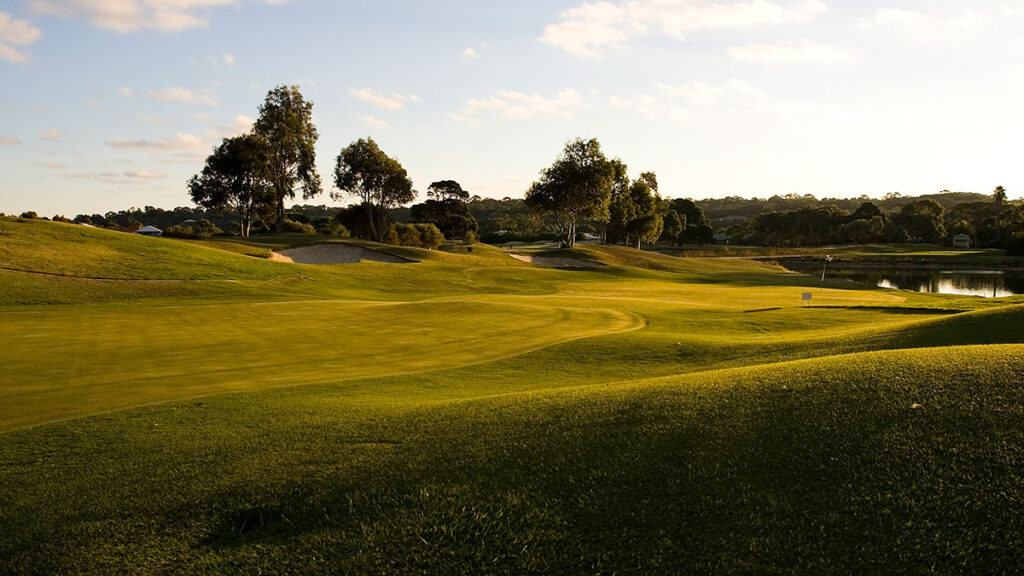
At nearby Victor Harbor – the town with no ‘u’ in its name but plenty of views – McCracken Country Club is an ideal base from which to play and stay. With 65 rooms spanning apartments, villas and hotel rooms, as well as a restaurant and bar/grill plus a swimming pool, spa, sauna and basketball and tennis courts, it is unapologetically a resort setup.
Like Mount Compass, it’s also a place to have felt the impact of LIV Golf, illustrating how far away from Adelaide the tentacles of the new enterprise have stretched. “The likes of LIV have really put the spotlight on all of South Australian golf, and it’s fantastic to see so many visiting the regions to play,” says McCracken general manager
Stuart Riddell.
The 6,066-metre, Tony Cashmore-designed McCracken course is mostly wide open but does feature water on more than half the 18 holes, which means if you’re going to spray it from time to time, you’d better pick your moment. It’s usually windy at Victor Harbor, so while there is ample space, there’s also ample challenge.
One unusual feature of the layout is its five par 5s, yet the oddity helped author the most famous story in the course’s history. While pursuing the leaders on the final day of the 1996 South Australian PGA Championship, the late Lyndsay Stephen eagled all five long holes on a day when he carded a 10-under 62. Technically not all five in one round, though, as he failed to eagle the 457-metre 18th hole in regulation play. He quickly corrected that, however, by hitting his 3-wood to tap-in range to eagle the 18th on the first playoff hole and defeat a luckless Craig Spence. It’s a legendary feat that lives on to this day, three years after Stephen’s sad passing. Players at last year’s PGA Legends Tour event at McCracken even commented about it 27 years after the fact, yet none were able to replicate Stephen’s remarkable quintet.
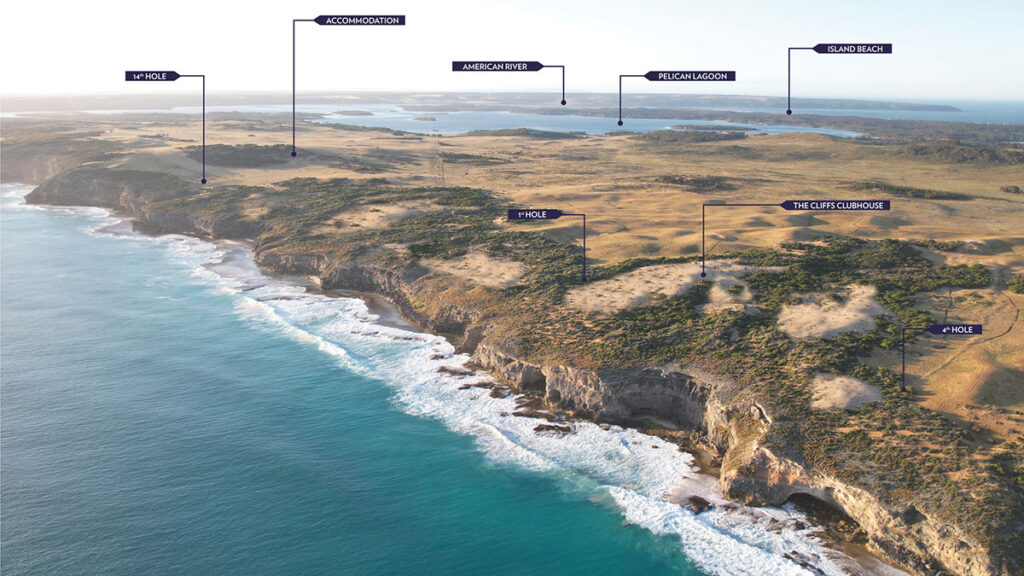
ON THE HOP
What’s next in South Australian golf? The exciting new course called The Cliffs Kangaroo Island, which is scheduled to open in late 2025. We spoke with its developer and chief executive officer, Sam Atkins.
Australian Golf Digest: What excites you most about The Cliffs Kangaroo Island?
Sam Atkins: As a golf course, the site is quite simply spectacular. The natural contours of the grasslands to the dramatic sand dunes give us the perfect canvas to build a world-class destination golf course with views, flora and fauna that you literally will not find anywhere else in the world. We are working with one of the best all-Australian teams assembled to build destination golf, who combine extensive experience and a passion for Kangaroo Island. Darius Oliver is our golf course designer, supported by Justin Trott (Programmed Turnpoint). Martin Greenwood (ex-Kingston Heath) will be staying on to head up the golf course team of Lindsay Richter, Glenn Peck and John Geary. All were involved in the successful delivery of Cape Wickham Links.
In terms of the off-course project – we are building a world-class clubhouse, restaurant and on-site accommodation, which will complement the golf course and take advantage of the vistas and topography. The views from our clubhouse will be one of the only spots on Kangaroo Island where you can see the Southern Ocean, Kangaroo Island’s million-year-old cliffs and the north shore of the island. Our accommodation site on the western hill will also offer similar vantage points and some amazing clifftop walks. The Cliffs Kangaroo Island restaurant will feature some of the island’s best produce and our executive chef, Katie Allen, is already working on a dynamic menu combining the best that Kangaroo Island and South Australia has to offer.
Our rectification and restoration of the landscape will ensure visitors will have a genuine Kangaroo Island experience of the rich wildlife and flora from the moment they arrive.
As for what it can do for the island, we believe Kangaroo Island offers one of the most unique visitor experiences in the world. It is one of the purest, most natural environments and ecosystems to be found, with no rabbits or foxes, which is particularly unique and good for growing grass. The local community is honest, genuine and committed to the island in a way that you can only understand if you visit. The Cliffs Kangaroo Island will add another first-class experience to the already significant opportunities for visitors on the island. It will invite a genre of traveller – the destination golfer – to visit Kangaroo Island when they may have not ventured past Tasmania or New Zealand in the past.
How would you describe the site – and the vistas – to someone who has never been to “KI”?
Unique, spectacular, world-class, rugged, peaceful, dramatic and dynamic all rolled in to one. You need to see the stars at night from the golf course. The site looks like it was laid out for golf a million years ago, with rolling contours combined with well-draining sands and fertile soils, housed behind a dramatic limestone ridge, high above the Southern Ocean with views to all parts of the island. The grasslands had been degraded after years of grazing and the introduction of noxious weeds, but we are restoring the 700 acres with careful removal of the weeds and the re-establishment of native grasses and plants with our own on-site nursery and team. You will have to see the views yourself to understand how breathtaking they really are, and your first tee shot will be one to remember.
What are the biggest challenges in building a golf course – and its associated infrastructure – on an island off the Australian coastline?
There are many, but the main challenge was building the right team and once we had achieved that the rest is just opportunity.



